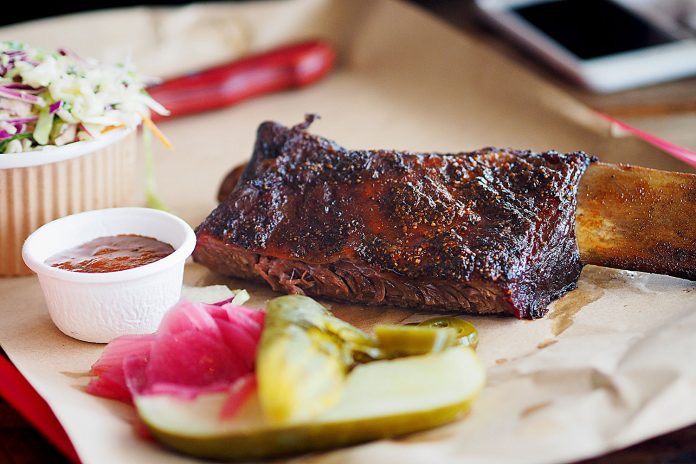Many SydneyCafes readers are avowed carnivores and we respect that. However we love our readers so much that we want you to taste a few things not on mainstream menus. So we asked DR PETER DINGLE, author of My Dog Eats Better Than Your Kids, to put a few facts on the public record from a scientific perspective that isn’t sponsored by the Australian Meat Board …
Some time ago I saw an ad on television featuring Sam Neill of Jurassic Park fame telling his audience that red meat is essential to good health and even promotes brain development. Unfortunately the claims were extremely exaggerated and misleading and failed to mention any of the numerous health effects of eating meat. So I thought I would set the record straight based on science, not profit.
 Human genetic makeup, shaped through millions of years of evolution, has determined our nutritional and activity needs. We have not evolved as meat eaters; we are omnivores who get a small amount of our calories from wild meat including insects and rodents. As such we do not have the body or digestive system of a big meat eater. Without tools, we would not even be able to hunt big game. Our teeth are naturally shaped for grinding—they are not sharp teeth designed for tearing and ripping. Our digestive organs and teeth most closely resemble those of our closest evolutionary cousins, the chimpanzees, gibbons, gorillas and orangutans. Our intestines are proportionally two to three times longer than those of cats or dogs (meat eaters by nature) and about half the length of the intestines of grazing animals such as cows and horses.
Human genetic makeup, shaped through millions of years of evolution, has determined our nutritional and activity needs. We have not evolved as meat eaters; we are omnivores who get a small amount of our calories from wild meat including insects and rodents. As such we do not have the body or digestive system of a big meat eater. Without tools, we would not even be able to hunt big game. Our teeth are naturally shaped for grinding—they are not sharp teeth designed for tearing and ripping. Our digestive organs and teeth most closely resemble those of our closest evolutionary cousins, the chimpanzees, gibbons, gorillas and orangutans. Our intestines are proportionally two to three times longer than those of cats or dogs (meat eaters by nature) and about half the length of the intestines of grazing animals such as cows and horses.
Meat is … Modern …
Until recently, meat made up a small part of our diet and, even then, was consumed only intermittently. In early times we ate our meat straight from the wild. We devoured rats and other rodents (we sure did, a bunny is a rodent), large insects (ever tried a Witchetty grub?), birds, small game and the occasional feast of big game. The meat meal was so precious that we made sure to eat the entire animal, including the organs and whatever we could suck from the bones. For thousands of years, humans prized the organ meats of animals more highly than a cut of steak from the muscle.
The meat was 4% to 6% fat, rich in minerals and Omega 3 oils and low in arachidonic acid (AA). The wild animals that humans consumed were forced to hunt for food and at times had to cover great distances to ensure their survival. In contrast, modern breeding practices have focused on selecting for animal breeds that accumulate large quantities of fat and on keeping animals relatively inactive to encourage weight gain (1). This trend is based partly on consumer demand and reinforced by agricultural grading processes (2).
Meatamorphised …
The meat we eat today is very different; it is high in saturated fat, high in arachidonic acid (which causes inflammation) and low in nutrients. Today’s meat is approximately 25% to 30% fat by weight, of which 50% to 60% is saturated and low in beneficial Omega 3 oils—despite advertising claims that meat is a good source of Omega 3 oils. Even low-fat farmed meat is higher in fat than game meat.
The problems caused by eating meat are further compounded by the fact that animals bred to become “edible” meat have been manipulated with hormones, antibiotics and diet to make them grow big (and fat). They are increasingly being grain-fed due to the consumptive demand by our supermarkets. Cattle were not designed to eat grain; they were designed to eat grasses with a very small amount of grain. Grass-fed beef is one-third to three times leaner than grain-fed beef. Grass-fed beef also provides two to four times more essential Omega 3 fatty acids than feedlot beef. Researchers have found grass-fed beef contains two newly discovered “good” fats: conjugated linoleic acid (CLA) and trans-vaccenic acid (TVA) (our bodies turn TVA into CLA) (3). Grass-fed beef also provides more beta-carotene, vitamin E and folic acid as well as some important antioxidants.
The Myth of Grain Fed Meat …
To the hungry eye, grain-fed meat may look better on the shelf but it is worse for you and for your family. Let’s not forget that it is also far worse for the welfare of the cattle and the environment. My experience of feedlot cattle is that the entire process is very inhumane. Particular culprits here are the big supermarket chains like Coles and Woolworths that demand grain-fed animals. Then growth hormones are added to some beef, but not others. To find out which ones, you can begin by asking your butcher (who may or may not know).
Meat and Disease …
Red meat consumption is associated with a wide range of chronic inflammatory illnesses including cardiovascular disease, colon cancer, breast cancer, prostate cancer, type 2 diabetes, osteoporosis and shortened life expectancy. There are countless published studies that confirm increased rates of certain cancers with high red meat consumption (4,5,6,7). More than three or four servings of meat per week is linked with an increase in cancers, particularly colorectal cancer and breast cancer. In a major US study, people with the highest intake of red meat experienced a statistically significant elevated risk of aesophageal, colorectal, liver and lung cancers (8). For processed meat consumption, people with the highest average intake of these meats (22.6 g per 1,000 kcal) were calculated to be at a 16 and 20 percent increased risk of lung and colorectal cancer, respectively. Possible reasons for this include dietary fat from the meat, compounds like N-nitroso compounds (NOCs), heterocyclic amines (HCAs) and polycyclic aromatic hydrocarbons (PAHs) formed during high temperature cooking. By contrast, eating poultry and fish in place of red meat did not increase the risk of colon cancer, but rather decreased the risk significantly (4).
In a recent study it was concluded that consumption of red meat was associated with higher risk of hormone-receptor-positive breast cancer in pre-menopausal women (9). In post-menopausal women, another study found red meat to increase the risk of breast cancer among women by up to 50%, specifically those who were overweight (10). One study of older women found consumption of red meat to increase the risk of developing non-Hodgkin’s lymphoma (11). Several studies have also found a direct correlation between red meat consumption and prostate cancer (5) Yet another study found meat intake positively associated with increased risk of pancreatic cancer—although the researchers suggest it may be a result of the toxins produced during cooking (12).
Red meat is associated with an increased risk of heart disease and stroke (13,14,15). Those who consumed red meat daily had a 60% greater chance of dying from a cardiovascular disease than those consuming red meat less than once a week (5). Changing just 5% of total energy intake in calories of adults from saturated fat to unsaturated fat would reduce their risk of heart disease by 42%. Yet the ads on television tell you that meat is essential. Don’t let truth get in the way of a good ad.
Many large epidemiological studies have found that vegetarians are less likely than meat eaters to have high blood pressure. In a study of 28,000 vegetarians and 48,000 non-vegetarians over a period of 10 years, the vegetarians were 24% less likely to die of ischemic heart disease, including heart attacks, compared to the non-vegetarians. Researchers also found that fish eaters had no more heart disease than vegetarians. In a study comparing monks (Trappists are strict vegetarians while Benedictines are not), researchers found lower blood pressure in the monks of the vegetarian Trappist monasteries.
Going Nuts … May Be The Answer …
In contrast to meat, nuts reduce the risk of fatal and nonfatal heart disease. Subjects who ate nuts five or more times per week, compared with those who ate nuts less than once a week, reduced their risk by approximately 31% to 37% in male vegetarians compared with those who ate meat three or more times a week (16).
Other studies have found a strong link between red meat and type 2 diabetes (17,18). This is thought to be partly due to the health effects of iron overload from red meat, which increases the risk of CHD and other cardiovascular health problems (19). Obesity, an increasing public health problem worldwide, has been shown to occur repeatedly in those who regularly consume red meat as part of a usual diet (14). Red meat intake increases the risk of Alzheimer’s disease (15). Women in the US show a positive association between chronic obstructive pulmonary disease and red meat intake (6). Numerous studies have also associated red meat consumption with osteoporosis and bone fractures (20). This is thought to be associated with an increase in the acid diet of meat eaters. Susceptibility of disease or risk of infection also seems to be lower amongst those avoiding red meat (14).
The benefits of reducing or eliminating red meat from the diet clearly outweigh keeping it in one’s diet.
Meat and the Environment …
Farming of red meat is one of the most environmentally destructive agricultural practices of modern times. Worldwide agricultural activity, especially livestock production, accounts for about a fifth of total greenhouse gas emissions, thus contributing to climate change and resulting adverse health consequences, including the threat to food yields in many regions. By decreasing one’s intake of red meat, the demand for livestock will decrease, lowering the devastating effects of livestock production. Likewise, livestock numbers will not be as high if their meat is not demanded by the human population, and thus the methane produced by livestock which contributes to global warming will also decrease (21). Modern meat production is an example of the inefficient use of natural resources. Modern methods of raising cattle use excessive amounts of grain, water and fossil fuels, and create both air and water pollution (22).
To be truly environmentally and globally conscious, one must think about at least cutting down meat consumption. Consider that, according to the organisation Compassion in World Farming, it takes 16 kilos of grain to produce one kilo of meat for consumer consumption (not to mention all the water and other resources used). Meanwhile, the United Nations reports that 160 million children under five are malnourished. Does it make sense that we are feeding grain to cows instead of to children?
Despite abundant evidence of the toxic effects of meat, the Australian government (and other governments of meat exporting countries) states that daily consumption of red meat is consistent with a healthy diet. The only possible reasons for this are the economic benefits and pressure from very powerful and large lobbying groups. Overall, it is accepted in the scientific journals that those limiting or avoiding red meat in the diet will live a healthy life with decreased risk of many chronic diseases. After a major US study was recently released and recommended reducing dietary consumption of meat, the American Meat Institute (AMI) took an opposing stance, calling the recommendations on meat consumption “extreme” and “unfounded.” According to the institute, “The advice to limit red and processed meats reflected their anti-meat bias.” The real bias, however, is not with the scientists who have nothing to gain or lose from changes in meat consumption.
Still not convinced? Here’s a recent Harvard study as published by the Sydney Morning Herald: Red meat boosts risk of dying young.
As a general rule animal proteins (meat, dairy and eggs) should not make up any more than 10% of your daily calories. Levels of animal protein above 10% increase the risk of most forms of chronic illness. By contrast plant proteins (nuts and beans) don’t show any negative health effects. Protein from white meat, fish, nuts, beans and legumes offers plenty of choices on the source of protein for a red meat-free diet, with none of the negative consequences.
Red meat is not the best source of protein nor is it essential for our survival. The meat we eat today no longer resembles the meat that was a part of our evolutionary diet. Game meat may have provided an evolutionary advantage to survive in tough times when we struggled to reach 50 years of age but the meat we eat now is what kills us and causes a lot of pain and suffering before we even get to fifty. The more red meat you eat the more you get sick. The choice is yours.
To find out more about living in a more conscious way, join Dr Peter Dingle at www.drdingle.com



